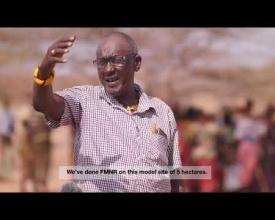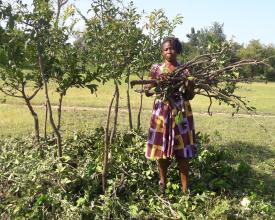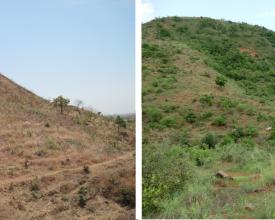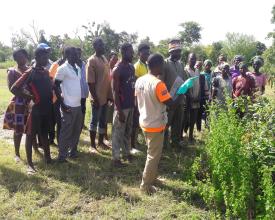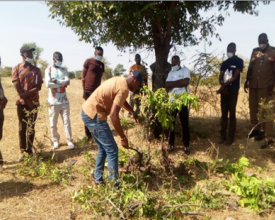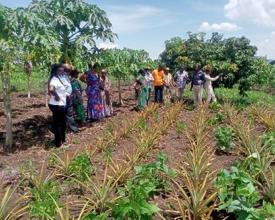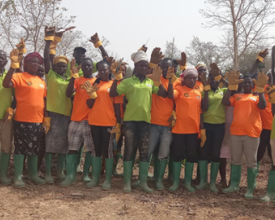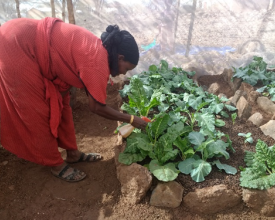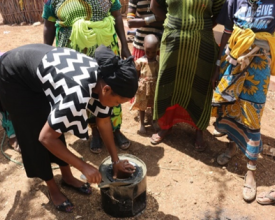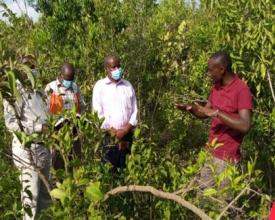Restoration, Development and Transformation through Farmer Managed Natural Regeneration (FMNR)
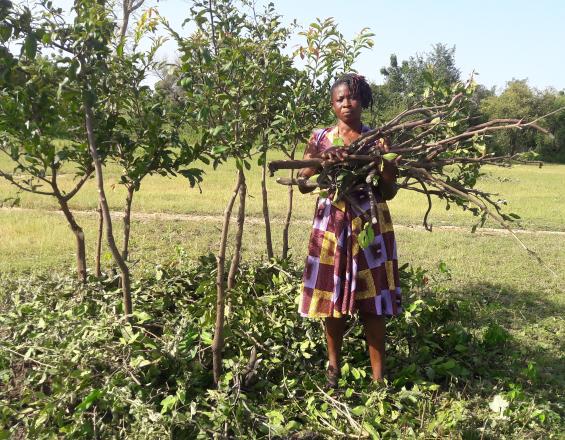
Land degradation has negatively affected the lives of many people around the world. Farmer Managed Natural Regeneration (FMNR) is a low-cost and evidence-based solution for communities to restore their land, increase land productivity, and build resilience. FMNR is more than tree management practice in light of the following principles:
- The systematic pruning and management of existing indigenous trees and shrubs by the land user
- A significant increase in tree and shrub coverage and biomass across the landscape
- An improvement in the ecological functionality and human well-being, as well as a primary driver for community development processes
FMNR is a practice for natural resource management and landscape restoration. With its holistic and transformative approach, FMNR is a foundation for sustainable development, climate change adaptation and mitigation, disaster risk reduction and other livelihoods development activities such as tree-based value chains, crop and livestock production.
Context
Challenges addressed
- In the wake of land degradation driven by deforestation, unsustainable land use practices and climate change, and more frequent and extreme weather events such as droughts, floods and storms, FMNR helps to restore ecosystem health by restoring soil structure and fertility, rehabilitating springs and water table, and increasing biodiversity
- When the productivity and health of forests, farm- and grazing lands is damaged, the livelihoods of people who depend on these resources is also under threat. With FMNR, communities restore degraded lands to productivity quickly and efficiently, supply fodder for animals and food for people, have access to sustainable source of firewood, and promote tree-based livelihoods activities
- Many rural populations suffer multidimensional vulnerability and poverty. The adoption of FMNR can tackle multiple social challenges by improving healthy lives and food security, eliminating poverty and reducing inequalities, and strengthening community resilience
Location
Process
Summary of the process
The four building blocks present FMNR as an integrative approach that requires technical capacity building, community development, livelihood strategies, and advocacy. It shows that to drive transformative change for the landscape and the communities that live in it, actions must be taken at multiple scales, from the community to local and national governments, and across systems, from forestry to agricultural systems. This latter one contributes to promote diversified livelihoods that increase households and community resilience.
These complementary actions demonstrate how the adoption and long-term impacts of FMNR can be promoted, making FMNR a fruitful component in building more cohesive, inclusive, and resilient communities.
Building Blocks
Getting started: the technical practice
FMNR is a technical practice which aims to restore natural environments through the systematic regrowth and management of existing trees and shrubs from tree stumps, sprouting root systems or wild seeds on diverse landscapes. As a technical practice, FMNR includes four components:
- Select: practitioners identify the number and species of trees and shrubs to be regenerated an/or actively managed in a landscape
- Prune: practitioners selectively remove the stems and side branches of regenerating indigenous tree stumps and shrubs to maximize growth and regeneration by directing resources and nutrients to a few selected stems and side branches
- Manage: practitioners manage pruned stumps and shrubs by periodically removing new stems and side branches, and by protecting those that remain from potential threats i.e., livestock, fire, humans, and competing vegetation by adopting, for e.g., improved grazeland and livestock management practices, social fencing, live fencing and/or fire breaks
- Utilize: practitioners utilize stems harvested for firewood, fodder or mulch with the understanding that shoots regenerating following harvesting of stems will be actively managed to expedite their recovery. As trees grow, practitioners may also utilize wild foods, traditional medicines, dyes, gums and other non-timber forest products.
Enabling factors
- Encourage community members to participate in FMNR demonstrations and workshops to increase common understanding about deforestation and the causes of land degradation.
- Involve all groups in the community in land-use decisions: Women and men, elders, youth and children, people with disabilities and those who do not farm the land, and all minority groups. In FMNR, the more people involved, the better
Lesson learned
While FMNR can be implemented alone, it is strongly encouraged that complementary NRM practices/approaches be integrated to better enable and accelerate the natural regeneration of trees in landscapes. At the same time it is equally important to incorporate other livelihoods practices/approaches, which in turn result in positive outcomes for the overall improvement of communities to build livelihood opportunities.
Promoting community development practice
FMNR represents a community development practice. In this sense, FMNR directly aims at participatory, inclusive and community-based and -owned analyses, plans, knowledge sharing and adoption. The following three components are critical in understanding and implementing FMNR as a community development process:
- Connect: Community member come together to participatory analyse, discuss and connect the root causes and consequences of deforestation and landscape degradation in their community. Once the connection has been made, FMNR is introduced as a potential solution.
- Plan: Community members engage in a participatory visioning process to identify common goals and agree on tangible actions to drive and enable the scale-up of FMNR on communal and privately owned/managed land. These plans can vary in formality and may be developed and refined over the years.
- Enable: Community member are trained in the technical knowledge and skills to adopt and promote the practice of FMNR on landscapes. This component also includes the identification, training and follow up of FMNR Champions who actively work to enhance the spread and adoption of FMNR in their communities.
Enabling factors
To build awareness and understanding around FMNR among peers, community leaders, and national governments as a low-cost scalable approach. This creates an enabling environment at the community and/or sub-national levels to facilitate its adoption in communities – for example through enabling policies and bylaws.
Lesson learned
Engaging the community in the right way from the beginning will be foundational to the success of any FMNR activities going forward. FMNR involves change: not just in the landscape, but often in the ways that people interact with each other. Understanding traditions, traditional roles and the dynamics of people in the community is an important part of engagement. Key principles of FMNR, such as inclusion and ensuring that women and minorities have equal rights and access, may require the community to carefully think through their values and norms. FMNR involves decision-making, therefore community ownership of the process is essential. The technical practices part of FMNR activities are important, but they will not succeed unless the people who use the land more broadly are in agreement on how to manage it, as well as the regeneration of the trees.
Leveraging local livelihood strategies
Integrating FMNR with livelihood activities is strongly recommended. For example, alternative livelihood development activities can support FMNR uptake by reducing household dependence on unsustainable timber harvesting for subsistence and/or sale. Complementary livelihood activities to support FMNR outcomes include:
- Agricultural development activities that promote sustainable intensification and/or diversification of smallholder agricultural production. Combining trees on cropland and pasture with conservation agriculture practices has proved to increase crop yields and improve livestock productivity.
- Market development activities that support more profitable marketing of products produced by smallholder farmers. They enhance the adoption and sustainability of FMNR by increasing smallholder incomes, thereby reducing the need for households to adopt coping strategies that can further damage the natural environment and reduce biodiversity.
- Energy-saving solutions (e.g. clean cookstoves) that support FMNR by reducing household demand for wood, thus increasing the likelihood that trees that can regenerate will not cut down or felled for their wood in unsustainable ways.
Enabling factors
Complementary livelihood activities, preferably those based on trees (e.g., agroforestry and woodlands), can offset short-term fluctuations in household and community resource availability and income that might otherwise undermine FMNR success by increasing pressure to use and cut trees.
Lesson learned
Implementing complementary tree-based value chain development activities, such as beekeeping, can improve FMNR uptake and sustainability by increasing its benefits and economic value to households and communities. In addition, FMNR can increase crop and livestock production by enhancing soil fertility, reducing soil erosion, improving water availability and increasing fodder.
Advocacy and stakeholder engagement
Advocacy activities help promote awareness and understanding of FMNR as a cost-effective and scalable approach to landscape restoration and climate resilience among practitioners, community leaders, and national government. This can promote acceptance among peers and encourage community leaders and government officials to create an enabling environment at the municipal and/or subnational level to facilitate the adoption of FMNR in communities (e.g., through relevant policies and regulations).
Enabling factors
- Mobilize national stakeholders to create a policy environment in support of adoption of FMNR in relevant strategic frameworks
- Identify and engage with other partner organizations to enhance the implementation of the FMNR approach
Lesson learned
Advocacy works for government recognition and formalization of the rights and responsibilities of those who practice FMNR. It creates an enabling policy environment that encourages individuals and communities to manage their natural resources sustainably.
Impacts
FMNR contributes to significant transformation of landscape, creating sustainable benefits for the communities and the environment. As a result of FMNR, tree cover and tree density increase, hectares of degraded land and natural resources are restored. In Niger, where the FMNR method was pioneered in 1980’s, nearly 6 million hectares of dry land have been regreened through the widespread use of FMNR. The resulting increase of tree cover on a landscape and the FMNR method lead to improvements in soil quality, microclimate, and water quality and availability.
The adoption of FMNR ranging from Honduras to Timor Leste, has been supported by significant knowledge and experience shared among community members beyond project interventions.
FMNR contributes to manifold positive impacts, such as:
- Enhancing climate change adaptation and mitigation (EbA and EbM)
- Improving food security and transforming food systems through agroforestry and silvopastoral systems
- Improving household livelihoods and resilience by increasing availability of wood and forests products as well as quality and quantity of crop yields
- Strengthening gender equality by improving access to resources and creating income generating opportunities for women
- Strengthening peacebuilding and social cohesion by bringing people together over the mutual benefits of a shared natural resource base and the act of working together to solve common problems
Beneficiaries
Because FMNR empowers people and communities, all groups (women, men, youth, people with disabilities, minorities) who use or have access to land must be involved. FMNR participants thus include farmers, pastoralists, local leaders, and government officials.
Sustainable Development Goals
Story
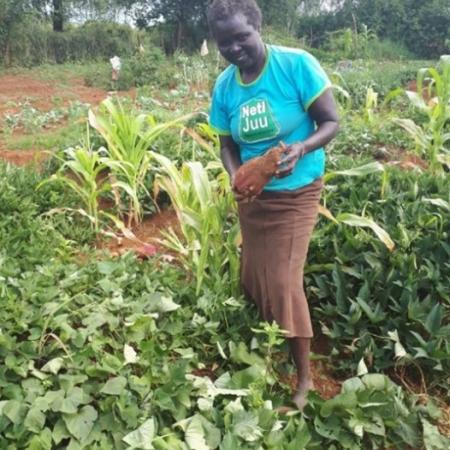
Nancy Kimboi, mother of five, has been a farmer all her life. Before she knew about FMNR, Nancy would wait for grass to grow so her cattle could graze. They had enough food until the dry season hit, and then there would be no more. To get money to buy grass, Nancy’s family cut down trees to make charcoal and firewood to sell.
Since Nancy learnt about FMNR, she now grows grass as a fodder crop and stores it safely from rain and rot, so it keeps well for the dry season. She leaves trees in her fields because she knows they allow the grass to grow better. These trees provide food for the cattle, firewood and medicine for the family. Leaves are composted to improve the soil. Her farmland is terraced to reduce soil erosion and retain water. She plants potatoes, cabbage, tomatoes and various other vegetables, and in between, she has maize and fruit trees. The fruit trees attract the bats and encourage birds to return, increasing the biodiversity of the ecosystem.
In the past four years, Nancy has been a model farmer for the FMNR approach and has trained ten other farmers herself. “My life has improved drastically,” she says, “because I have a diversified income now. From my maize crops and vegetables and from my beekeeping, I was able to buy a better breed of cows, the sisal variety, and these cows give a lot more milk, so I am making much more income now.”
